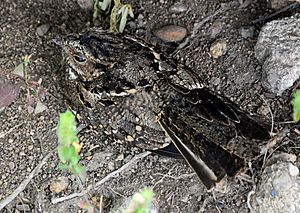Anthony's nightjar facts for kids
Quick facts for kids Anthony's nightjar |
|
|---|---|
 |
|
| Conservation status | |
| Scientific classification | |
| Genus: |
Nyctidromus
|
| Species: |
anthonyi
|
 |
|
| Synonyms | |
|
Caprimulgus anthonyi |
|
The Anthony's nightjar (Nyctidromus anthonyi), also known as the scrub nightjar, is a special type of bird. It belongs to the nightjar family, called Caprimulgidae. You can find this bird living in Ecuador and Peru.
Contents
About This Bird
Anthony's nightjar was first described in 1923. For a while, scientists thought it was part of a different bird group. But thanks to new studies, like looking at its DNA and listening to its calls, they realized it needed its own group. It's now grouped with its close relative, the pauraque. This bird is monotypic, which means it's the only species in its specific group.
What It Looks Like
Male Anthony's nightjars usually weigh around 35 g (1.2 oz). Females are a bit heavier, weighing about 37 g (1.3 oz).
- Males: Their top feathers are grayish-brown with small buff (light yellowish-brown) spots and dark brown stripes. The top of their head is darker. They have a wide, tawny-buff collar around their neck. Their tail feathers are mostly brown, but the outer ones have a lot of white. Their chin and upper throat are tawny-buff with dark brown lines. The lower throat is white, and the chest is grayish-brown. Their belly and sides are buff with light brown lines. When they fly, you can see a white or buffy stripe on their wing feathers.
- Females: They look similar to the males, but they have less white on their wings and tail.
Where It Lives
Anthony's nightjar lives along the coast of western Ecuador and in northern Peru. These birds usually stay in one place. However, they might move short distances when it rains. They like dry, open woodlands, grasslands, and areas with shrubs. You can find them from sea level up to about 800 m (2,600 ft) high.
How It Behaves
Anthony's nightjar is active from when the sun goes down until it comes up again. During the day, it rests on the ground, usually by itself.
What It Eats
Even though Anthony's nightjar is active all night, it does most of its hunting at dusk and in the early evening. It catches insects while flying or by quickly flying out from a branch to grab them. It prefers to hunt in open or partly open areas.
Family Life
Scientists aren't sure exactly when Anthony's nightjar breeds. But it seems to happen mostly between December and March, and it might depend on when the rain falls. The female lays just one egg directly on the ground, often on top of fallen leaves.
What It Sounds Like
Anthony's nightjar sings mostly at dusk and dawn. Its song is simple, sounding like a short treeow or keeLEEoo. It sings this from the ground or a low branch. It also makes a rolling quaqrr sound from a perch and a soft tuk tuk tuk call when it's flying.
Its Status
The IUCN (International Union for Conservation of Nature) has looked at Anthony's nightjar and decided it is a species of Least Concern. This means it's not currently in danger of disappearing. We don't know exactly how many there are, but their numbers seem to be growing. This might be because more forests and thick bushes are being cleared, creating more of the open areas they like.
See also
 In Spanish: Chotacabras de Anthony para niños
In Spanish: Chotacabras de Anthony para niños


